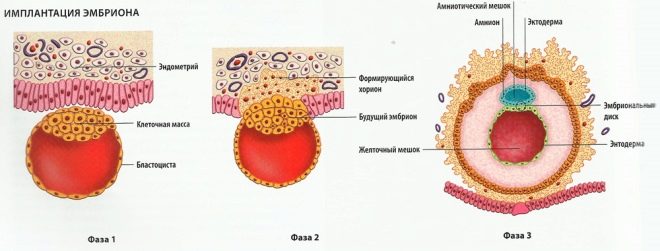Dark discharge during pregnancy
The appearance of a specific dark-colored discharge from the genital tract during pregnancy can alert every woman. The occurrence of dark vaginal discharge may be a manifestation of the development of dangerous pathologies or be a variant of the norm. This article will tell you more about the appearance of dark discharge from the genital tract during pregnancy.
Causes
In the normal course of pregnancy, the vaginal discharge has a rather light color. They can also be transparent. Much less often vaginal secretions change their color to darker. This usually happens at the very beginning of pregnancy.
Conventionally, all the causes of dark discharge can be divided into two broad categories:
- physiological;
- pathological.
Physiological discharge occurs mainly in the first half of pregnancy. They are accompanied by a smaller change in the color of the vaginal secretion. Their occurrence, as a rule, does not lead to a significant deterioration in the well-being of a pregnant woman.
Pathological secretions can develop in both the first and second half of pregnancy. Such secretions, as a rule, are characterized by the presence of a dark coloration, and are also accompanied by the occurrence of other adverse symptoms. It is very difficult for a woman to determine the difference between physiological and pathological secretions on her own.
Standard options
The physiological "darkening" of the vaginal secretion may be a consequence of the active release of ovarian hormones after the fertilization of the egg by spermatozoa. In this case, the appearance of light brown scanty discharge can be a "signal" for a woman that her condition has changed, and she is already pregnant.
If at the same time the woman notes the delay in the arrival of menstruation, and she had unprotected sexual intercourse, then she should go for a pregnancy test. It is likely that it will be positive.
Another special condition in which a woman may have light brown vaginal discharge is implantation. At this time, the fertilized egg is “implanted” in the uterine wall. During such fixation, a small amount of blood may be released.
At the same time, droplets of blood mix with the vaginal secretion, changing its color. Typically, such colored discharge women notice as spots on their underwear.
Implantation is quite a physiological event. As soon as it stops, the color of the vaginal discharge also changes - they become, as before, fairly light or even transparent.
Another possible reason for the natural "darkening" of vaginal secretions is the development of a special element of pregnancy - the mucus plug. Normally, it appears in the female ways to protect a small embryo from various infections.
When a mucus plug forms, a large amount of thick mucus begins to form. Over time, it mixes with exfoliated epithelial cells of the genital tract, leading to the fact that the vaginal secretion acquires a different color. Often it becomes cream or brownish.
Possible pathologies
The appearance of dark discharge can be conditionally divided by the duration of pregnancy. In certain situations, dark discharge from the genital tract can begin at the very beginning of pregnancy and persist almost until the birth.
In the early stages
The reasons that contribute to the appearance of dark and even black vaginal discharge in the very first months of pregnancy can be very diverse. Doctors identify several of the most common of them.
Ectopic pregnancy
This pathology is directly related to impaired implantation of a fertilized egg. In this pathology, the fertilized egg is not fixed to the wall of the uterus, but to its appendage - the fallopian tube. The course of tubal pregnancy is not provided by nature, since the fallopian tube does not have the same muscular structure as the main genital female organ, the uterus.
As the fertilized egg grows, the fallopian tube also expands. At the same time in the female body begins to change hormones. All of these specific changes may cause a sudden rupture of the fallopian tube and massive bleeding.
Adverse symptoms characteristic of ectopic pregnancy, often appear at 6-8 weeks from the moment of conception. In this case, a woman may appear dark brown vaginal discharge, which, as a rule, accompanied by the appearance of pain in the abdomen. At the same time, dark discharge can be both abundant and moderate.
Infectious diseases of the reproductive organs
These pathologies are currently found in gynecological practice quite often. Such diseases are caused by pathogenic bacteria, viruses, fungi or protozoa. Also in this group of diseases can include all infections that are sexually transmitted.
Identify actively developing infection is quite simple. Usually, a woman has dark (even “dirty”) vaginal discharge, which may have a yellowish or greenish tint. It can also cause itching and even swelling of the genitals.
A special treatment is required to eliminate the adverse symptoms. During pregnancy, especially in its first half, it is necessary to resort to the prescription of antibacterial agents in order to correct the resulting violations very carefully.
You shouldn’t do this yourself; you should always consult a doctor before prescribing any antibiotic.
On late terms
The appearance of dark discharge in the last stages of pregnancy can be a sign of the development of quite serious pathologies. For example, any infection may occur. In this case, the woman's general condition worsens, her body temperature may rise, and redness or itching in the vagina may occur.
If such adverse symptoms occur, do not hesitate to contact an obstetrician-gynecologist. The doctor will conduct a mandatory clinical examination, during which he will be able to guess the cause that led to the development of such adverse symptoms. If necessary, the doctor will select and individual treatment regimen.
An obstetrician-gynecologist will tell you more about vaginal discharge in the next video.

























